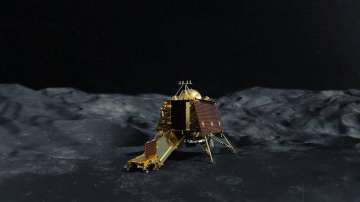In the early hours of Saturday when India attempts a soft landing on the lunar surface, 'Vikram' and 'Pragyaan' will be the cynosure of all eyes.
The 1,471-kg lander of Chandrayaan-2 -- first Indian mission to explore the lunar terrain with home-grown technology -- is named Vikram after Dr Vikram A Sarabhai, the father of the Indian space programme.
The lander is designed to execute a soft landing on the lunar surface, and to function for one lunar day, which is equivalent to about 14 earth days.
Chandrayaan-2's 27-kg rover is a six-wheeled robotic vehicle named Pragyaan, which translates to 'wisdom' in Sanskrit.
It can travel up to 500 metres from the landing spot on the Moon and leverages solar energy for its functioning.
It can only communicate with the lander, while Vikram has the capability to communicate with IDSN (Indian Deep Space Network) at Byalalu near Bengaluru, as well as with the orbiter and rover.
"The lander carries three scientific payloads to conduct surface and subsurface science experiments, while the rover carries two payloads to enhance our understanding of the lunar surface," according to ISRO.
Vikram will perform a series of complex braking manoeuvres to soft-land in the South polar region of the Moon between two craters, Manzinus C and Simpelius N, on September seven.
A few hours later, the rover Pragyaan will roll down from Vikram and will explore the surrounding lunar terrain.
Chandrayaan-2, a follow-on mission to the Chandrayaan-1 venture launched more than a decade ago, comprises an orbiter, lander (Vikram) and rover (Pragyaan).
The mission life of the orbiter will be one year while that of the lander and rover will be one lunar day which is equal to 14 earth days.
ALSO READ | Video: Step-by-step guide of Vikram's soft landing on Moon's south pole
ALSO READ | Chandrayaan 2 Moon Landing LIVE: India prepares to stay awake tonight for '15 minutes of terror'
ALSO READ | Chandrayaan-2: Pragyan rover will have company on moon, won't be only thing moving on lunar surface
